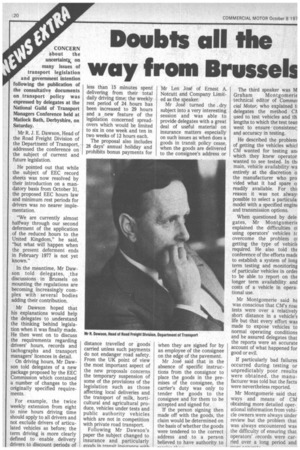Doubts all the way from Brusseh
Page 22

If you've noticed an error in this article please click here to report it so we can fix it.
CONCERN about the uncertainty, on many issues of transport legislation and government intention following the publication of the consultative documents on transport policy was expressed by delegates at the National Guild of Transport Managers Conference held at Matlock Bath, Derbyshire, on Saturday.
Mr R. J. E. Dawson, Head of the Road Freight Division of the Department of Transport, addressed the conference on the subject of current and future legislation.
He pointed out that while the subject of EEC record sheets was now resolved by their introduction on a mandatory basis from October 31, the proposed EEC hours law and minimum rest periods for drivers was no nearer implementation.
"We are currently almost halfway through our second deferment of the application of the reduced hours to the United Kingdom," he said, "but what will happen when the present deferment ends in February 1977 is not yet known."
In the meantime, Mr Dawson told delegates, the discussions in Brussels on mounting the regulations are becoming increasingly complex with several bodies adding their contribution.
Mr Dawson hoped that his explanations would help the delegates to understand the thinking behind legislation when it was finally made. He then went on to discuss the requirements regarding drivers' hours, records and tachographs and transport managers' licences in detail.
On driving hours, Mr Dawson told delegates of a new package proposed by the EEC Commission which contained a number of changes to the originally specified requirements.
For example, the twice weekly extension from eight to nine hours driving time should apply to all drivers and not exclude drivers of articulated vehicles as before; the term driving is more clearly defined to enable delivery drivers to discount periods of less than 15 minutes spent delivering from their total daily driving time; the weekly rest period of 24 hours has been increased to 29 hours and a new feature of the legislation concerned spreadovers which would be limited to six in one week and ten in two weeks of 12 hours each.
The proposal also includes 28 days' annual holiday and prohibits bonus payments for distance travelled or goods carried unless such payments do not endanger road safety. From the UK point of view the most important aspect of the new proposals concerns the temporary suspension of some of the provisions of the legislation such as those affecting local deliveries and the transport of milk, horticultural and agricultural produce, vehicles under tests and public authority vehicles which are not in competition with private road transport.
Following Mr Dawson's paper the subject changed to insurance and particularly goodc in trAnqii Mr Len Jose of Ernest A. Notcutt and Company Limited as the speaker.
Mr Jose turned the dry subject into a very interesting session and was able to provide delegates with a great deal of useful material on insurance matters especially on such issues as when does a goods in transit policy cease, when the goods are delivered to the consignee's address or when they are signed for by an employee of the consignee on the edge of the pavement.
Mr Jose said that in the absence of specific instructions from the consignor to place the goods in the premises of the consignee, the carrier's duty was only to tender the goods to the consignee and for them to be accepted and signed for.
If the person signing then made off with the goods, the claim would be determined on the basis of whether the goods were tendered to the correct address and to a person believed to have authority to The third speaker was M Graham Montgomerie technical editor of Commei cial Motor, who explained ti delegates the method CA used to test vehicles and th, lengths to which the test tean went to ensure consistenc: and accuracy in testing.
He described the problem of getting the vehicles whicl CM wanted for testing an which they knew operator wanted to see tested. In th( main, vehicle availability wa entirely at the discretion o the manufacturer who pro vided what it had spare a readily available. For thi: reason it was not alway: possible to select a particulai model with a specified engin( and transmission options.
When questioned by dele. gates, Mr MontgomeriE explained the difficulties oi using operators' vehicles tc overcome the problem oi getting the type of vehicle required. He also told the conference of the efforts made to establish a system of long term testing and monitoring of particular vehicles in order to be able to report on the longer term availability and costs of a vehicle in operational use.
Mr Montgomerie said he was conscious that CM's roat tests were over a relatively short distance in a vehicle's life but that every effort was made to expose vehicles to normal operating conditions and he assured delegates that the reports were an accurate account of what happened for good or evil.
If particularly bad failures occurred during testing or unpredictably poor results were obtained, the manufacturer was told but the facts were nevertheless reported.
Mr Montgomerie said that ways and means of CM obtaining more detailed operational information from vehicle owners were always under review but the problem that was always encountered was the difficulty of ensuring that operators' records were carried over a long period and




















































































